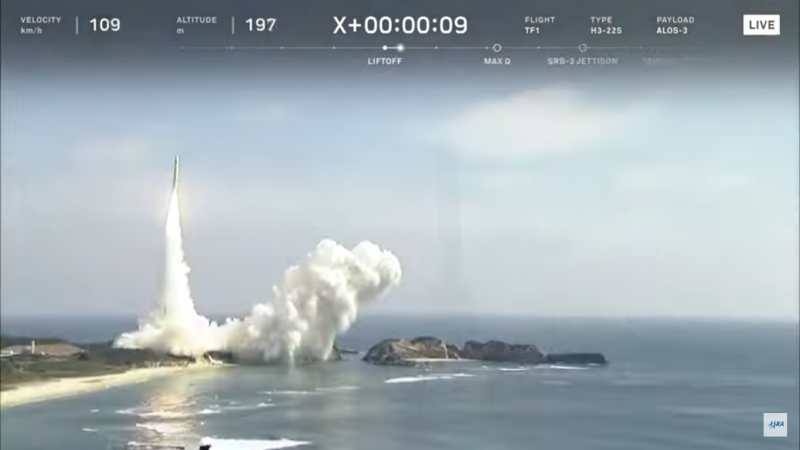The Japanese rocket failed to launch successfully.
Japanese rocket fails to make orbit
A second attempt at a maiden orbital flight for the Mitsubishi Heavy Industries H3 launch vehicle ended in failure Monday. It was March 6, 2023, according to U.S. clocks and March 7 in Asia. The rocket – which Mitsubishi’s website still lists as in development – was carrying the Japanese Aerospace Exploration Agency (JAXA) Advanced Land Observing Satellite-3. It lifted off at 01:37 UTC from the Tanegashima Space Center in Japan.
According to the official live broadcast from JAXA, flight controllers destroyed the H3’s second stage and payload by remote command.
It was the second attempt at a first flight for the H3. Due to an electrical hiccup, JAXA scrubbed a previous launch attempt in mid-February moments before the scheduled liftoff.
Last chance to get a moon phase calendar! Only a few left. On sale now.
Second stage didn’t burn
All systems aboard the H3 were operating nominally for the first five minutes after liftoff. The craft’s solid rocket boosters separated successfully at 1 minute, 56 seconds, followed by the payload fairing jettisoning at 3 minutes, 32 seconds. The rocket’s first stage completed its burn on time at 4 minutes, 56 seconds into the flight.
The spaceship’s second stage separated 8 seconds later. However, its engine failed to ignite, dooming the mission.
As the spacecraft reached an altitude of 190 miles (307 km), traveling 7,822 mph (12,589 km/h) – the moment of the anomaly – the previously busy commentary of the live broadcast went silent. At exactly 5 minutes into the flight, the craft’s velocity indicator showed it slowing. But the vehicle continued to gain altitude as momentum carried it.
On Twitter, Chris Bergin of NASASpaceflight.com described the rocket’s progress as “dropping like a stone.”
The velocity is dropping like a stone. It's either failed or the telemetry is wrong. pic.twitter.com/oyllKvXja8
— Chris Bergin – NSF (@NASASpaceflight) March 7, 2023
At 8 minutes, 31 seconds, flight controllers announced they were unable to confirm second stage ignition. And moments later, as telemetry seemed to indicate the craft’s gain in altitude had slowed considerably to around 392 miles (631 km), live updates ended, replaced by a written message:
We are currently checking the status. Please wait.

Auto-destruct sequence activated
After several minutes without an update, flight controllers announced at 14 minutes, 43 seconds that they ordered the craft to self-destruct.
Destruct command has been transmitted to H3 because there was no possibility of achieving the mission. We are confirming the situation.
The message then repeated, followed moments later by an ominous end-of-transmission announcement:
The status of H3 launch vehicle number one will be announced to all launch operators as soon as it will be confirmed. We are ending today’s launch status report.
Commentators for JAXA said the craft’s rocket was “disrupted,” causing it to fall back to Earth. The broadcast ended moments later.
JAXA satellite lost
The failed H3 was carrying an important upgrade to the JAXA Advanced Land Observation Satellite (ALOS) mission. Unfortunately, the replacement satellite – ALOS-3 or DAICHI-3 – was destroyed along with its launch vehicle over the Pacific Ocean.
JAXA said the instruments aboard ALOS-3 would have provided imagery of the entire planet at a resolution of less than 1 meter:
The sensor on board ALOS-3 is designed for an improved ground resolution (0.8 m) and wide-swath (70 km) simultaneously by expanding the size and upgrading performance compared to that of ALOS. ALOS-3 observations regularly cover all of the land areas of not only Japan but also across the whole world.
The imagery it produced was intended to aid in disaster response:
ALOS-3 aims to become one of the key tools for disaster management and countermeasures of the central and local governments; therefore, ALOS-3 is always ready for urgent observation of the affected area wherever disaster strikes. In addition to that, the system for product distribution is also developed in order to deliver images for both before and after the disaster to users swiftly.
Bottom line: The Japanese H3 rocket failed to reach orbit on its maiden flight. The spacecraft and its payload, a JAXA satellite, were lost.











